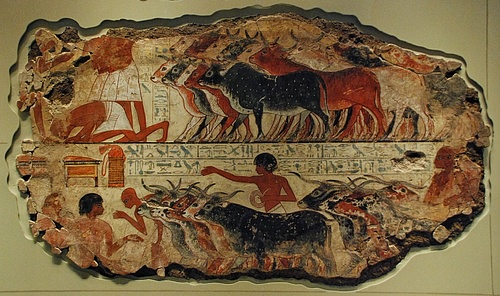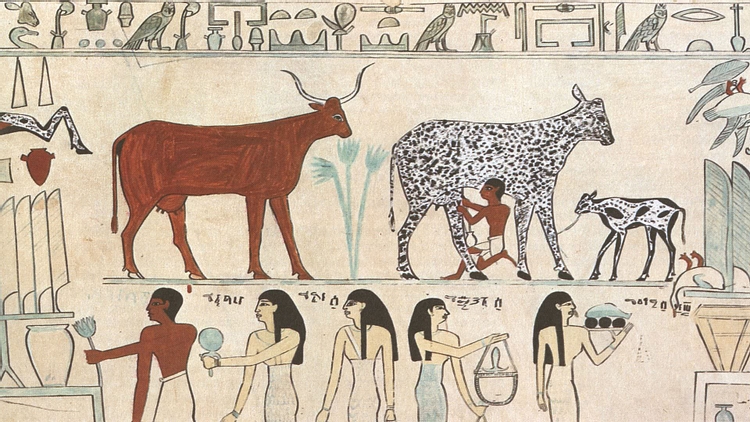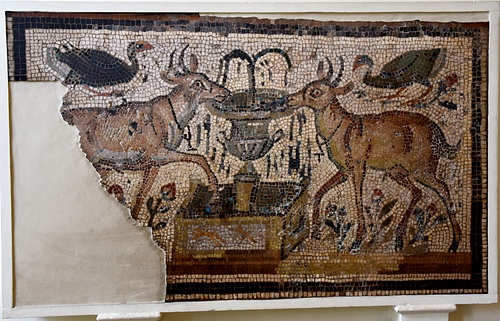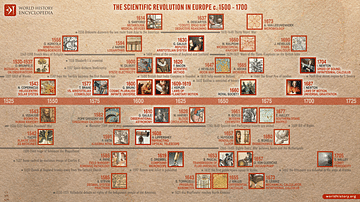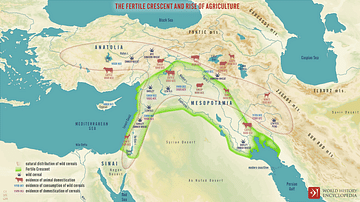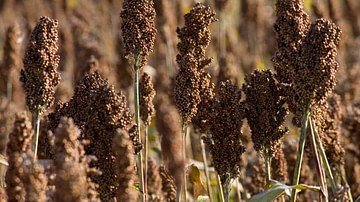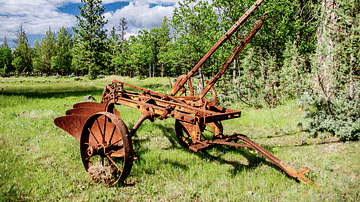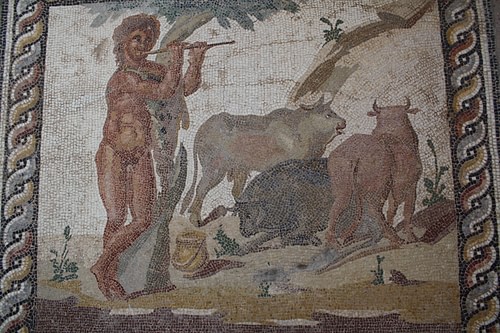
Animal Husbandry is commonly defined as a branch of agriculture dealing with the domestication, breeding, and rearing of animals for various purposes including labor (as in the case of large animals), a food source, protection, and companionship (as with dogs, primarily), and a source of material goods such as hides and bones, used for clothing and tools.
The domestication of animals is dated to the First Agricultural Revolution of c. 10,000 BCE, though probably began much earlier, and significantly changed how people lived. Prior to the domestication of animals, human communities revolved around the hunter-gatherer paradigm in which wild animals were hunted and plant life gathered; afterwards, domesticated animals and plants encouraged the establishment of permanent settlements with resources at hand for the needs of the people.
The first animals domesticated were dogs, used for hunting, protection, and companionship, with sheep and goats probably next and then other animals such as chickens. Larger animals, like horses and oxen, were likely domesticated after smaller ones. Herbivores were chosen because they could live off the land, and it is for this reason that scholars maintain domestication of plant life must have preceded that of animals - there needed to be a reliable food source in order for the animal population to thrive – though this claim has been challenged.
Once established, animal husbandry is understood to have benefited humans in many ways but also to have raised the standard of living of animals who were now protected and cared for. Beginning in the 18th and 19th century (though there are earlier examples), this claim was challenged by animal rights activists, who argue that animal husbandry benefits humans to the detriment of animals and the environment, it has come to be driven by profit without regard for the welfare of animals, and continued commercial animal husbandry in the modern age is ultimately unsustainable.
Pathways to Domestication
The English word 'domestication' comes from the Latin domesticus referring to the home ("belonging to the house") while husbandry means "to care for" or "manage prudently," and, applied to animals, is the care for, breeding, and management of formerly wild species of animals by human beings. It is thought that the domestication of animals was encouraged by climate change following the last Ice Age c. 21,000 years ago which dispersed game and forced people to travel greater distances to hunt and forage for food. Seeds dropped from plant life they foraged, it is thought, were observed to sprout, encouraging the intentional planting of such seeds and the beginning of agriculture.
Dogs are thought to have already been domesticated in Europe by this time as their dates have been determined at roughly 32,000-18,800 years ago, with the earlier time period favored. Dogs are thought to have developed from the Asian wolf and the European grey wolf, and while which was domesticated first continues to be debated, it is likely that the Asian wolf was first and was then transported to Europe where these now-domesticated animals might have encouraged the European wolves to trust and draw near to human communities – though this claim is speculative and has been challenged.
It is impossible to know for certain how the first animals were domesticated, but geneticists and scholars have developed various theories which have been accepted as reasonably sound. Scholar Melinda A. Zeder, for example, in her Pathways to Animal Domestication, outlines the three routes taken in the domestication of animals which is widely accepted by the academic community:
- Commensal Pathway: Habituation – Partnership – Directed Breeding
- Prey Pathway: Prey – Game Management – Herd Management – Breeding
- Directed Pathway: Competitor – Prey – Control – Directed Breeding
In the Commensal Pathway, the animal becomes used to humans by association. Wolves, for example, were most likely domesticated through their attraction to the bones or offal of a community's garbage pit or, perhaps, by scraps thrown to them. In time, the wolves were habituated to humans, entered into a mutually beneficial partnership, and were then directly bred for different purposes. Cats would have followed this same pathway to domestication.
Prey Pathway refers to animals such as horses, cattle, sheep, and goats which were initially human prey. These animals would have been domesticated individually, eventually becoming managed as herds and, again, subject to directed breeding according to human needs. The former prey, after domestication, becomes a partner in the human community and, again, is understood as benefitting as much from the relationship as humans.
Directed Pathway concerns animals who were formerly competitors for prey or were prey themselves (such as horses, donkeys, camels, and elephants, among others) who are brought under human control and then bred for specific purposes. In the case of the elephant, this would have been for labor, hunting, warfare, or entertainment as evidenced by their use in the arenas of ancient Rome. Zeder comments:
This fast-track to domestication begins when humans use knowledge gained from the management of already domesticated animals to domesticate a wild species that possesses a resource or a set of resources that humans see as desirable. (246)
It is thought that, after the domestication of the dog, humans used the same kinds of approaches in attracting and domesticating other animals.
Ancient Domestication
As Zeder notes, the path to domestication neither did always proceed quickly nor was the sedentary, agrarian lifestyle instantly embraced by hunter-gatherer communities. The evolution from nomadic hunters to sedentary farmers and animal breeders was a slow process. Scholar Marc van de Mieroop comments:
There was not a sudden change from hunting-gathering to farming, but rather a slow process during which people increased their reliance on resources they managed directly, but still supplemented their diets by hunting wild animals. Agriculture enabled an increase in continuous settlement by people. (12)
In Mesopotamia, the domestication of plants and animals was already established by c. 10,000 BCE. Excavations of refuse dumps outside of Mesopotamian towns and cities have shown a gradual decline in the number of wild gazelle bones after 7000 BCE (which, it has been suggested, shows a depletion of wild game) while the number of domesticated sheep and goat bones grows in number. Scholars have determined that these sheep and goats were domesticated, and not wild, based upon the condition of the bones and, of course, on inscriptions and artwork.
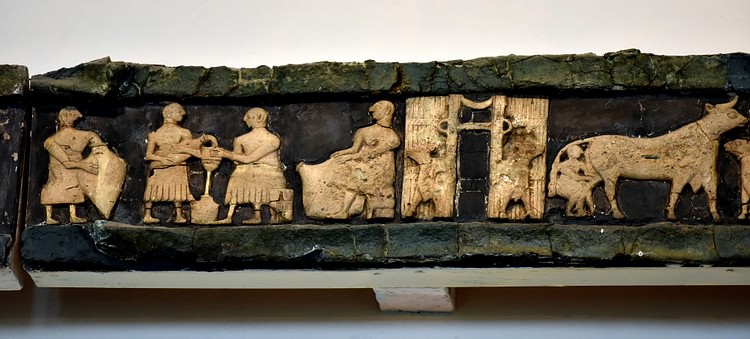
It is thought likely that wild sheep and goats came to graze around human settlements in an attempt to escape from natural predators who would have avoided contact with humans. In time, these animals grew increasingly tame and became an easily accessible source of food, following the route of Zeder's Prey Pathway. Wheat was domesticated and in wide use in Mesopotamia by 7700 BCE, goats by 7000 BCE, sheep by 6700 BCE, and pigs by 6500 BCE. By the time of the establishment of the city of Eridu in 5400 BCE, animal husbandry was widely practiced, and domesticated animals were used in the workforce (such as in plowing), as pets, and as a food source. Horses were tamed by 4000 BCE and, in time, became an important component in warfare.
This same basic pattern has been determined in the regions of the Indus Valley Civilization, Egypt, and China. In the Indus Valley, plants and animals were domesticated by the time of the pre-Harappan period (c. 7000 to c. 5500 BCE), and domestication was established prior to the Predynastic Period in Egypt (c. 6000 to c. 3150 BCE) and prior to the foundation of Banpo Village in China (c. 4500-3750 BCE) where they kept domesticated dogs and pigs.
At roughly the same time, humans in other parts of the world were engaged in the same practice. In the Americas, during the Archaic Stage (8000-1000 BCE) permanent settlements were established as plants and animals were domesticated. The Caral-Supe civilization, the oldest in the Americas (in modern-day Peru), was already cultivating the 'three sisters' of squash, beans, and corn, as well as other vegetables, and had domesticated the llama as a pack animal prior to 3000 BCE. The Olmec civilization, the Maya, the Aztec Empire, and others followed the same model as did those to the north of them who established the great cultural centers such as Cahokia and Poverty Point.
Domestication of plants and animals produced a dramatic change in the way people lived. Civilizations that had relied on hunting and gathering as a means of subsistence now built permanent settlements and engaged in a pastoral existence relying on their cattle and crops. The Agricultural Revolution, in fact, is considered the starting point for civilization as it enabled the five aspects which define that concept:
- surplus food
- division of labor
- urbanization
- government
- a writing system
Further, once people realized that animals could be tamed, the creatures became incorporated into the most basic and widespread rituals of the culture, notably in religious rites as sacrificial offerings or as representatives of the gods and the concept of order.
Domestication & Order
In Mesopotamia, Egypt, and other civilizations, the gods were associated with the establishment of order. In time, the domestication of animals seems to have acquired the same meaning. Humans, as co-workers with the gods in maintaining the ordered world, were doing their part in taming that which had been wild and bringing it under their control.
Worship of animals in Egypt is well known, most notably their reverence for the cat, associated with the goddess of the hearth and home, Bastet, but many ancient cultures incorporated animal imagery into their religious icons and practices. Wild animals came to represent untamed forces in the universe (such as the lions of the goddess Inanna in Mesopotamia), while domesticated creatures symbolized comfort and security (for example, the dog in Greece and Rome). In India, according to scholar Will Durant:
There was no real gap between animals and men; animals as well as men had souls and souls were perpetually passing from men into animals and back again; all these species were woven into one infinite web of karma and reincarnation. The elephant, for example, became the god Ganesha, and was recognized as Shiva's son; he personified man's animal nature and, at the same time, his image served as a charm against evil fortune. (509)
Hinduism, Jainism, and Buddhism all taught the concept of reincarnation and encouraged the belief, as Durant notes, that the souls of animals were of the same eternal substance as those that animated humans. In domesticating animals, people were drawing them from a perilous world of uncertainty to the safety of the human community. The people of the Indus Valley Civilization are thought to have worshipped a Mother Goddess whose male consort is depicted in the company of wild animals, possibly a reference to the gods' approval of their domestication or of the gods offering protection against elements beyond human control. The domesticated animal came to symbolize order as opposed to the chaos of the untamed world.
Animal husbandry, as defined specifically as care for animals, reached its height in the ancient world in Egypt where cats and dogs were cared for as though they were part of the human family in which they lived. Mummies of cats and dogs have been discovered in tombs in Egypt, and so deeply did the Egyptians feel for their cats, Herodotus notes, that they would shave their eyebrows and form a funeral procession of mourning upon the death of one of these pets. Other animals were also mourned as fully as any family member, and this practice was later observed in Greece and Rome where monuments to departed pets were erected.
Once domesticated, animals became a part of the human story, and just as people labored in the service of the gods, so animals served people. Scholar Stephen Bertman comments:
In ancient Mesopotamia, the most important domesticated animals were oxen and donkeys, on the one hand, and sheep and cattle on the other. The former served as draught animals; the latter were raised for their milk and for hides and wool that could be converted into clothing…Farmyards also included ducks and geese raised for their eggs and meat…and there is evidence that the ancient Mesopotamians raised pigs. (246)
Animals were bred to serve these and many other purposes in ancient Mesopotamia but were also directly linked with divinity just as they may have been in the Indus Valley. Gula, the Sumerian goddess of healing, is routinely depicted in the company of a dog, and they often appear as amulets for protection. This same paradigm holds for Mesoamerica where animals were associated with the divine, especially dogs who were thought to be able to safely conduct the souls of the dead to paradise.
Conclusion
At the same time that dogs, and other animals, were associated with divinity, they were kept as a food source and understood primarily as utilities in the service of humanity. An interesting observation to come from the field of genomic archaeology is how selective breeding of domesticated animals changed the various species. The floppy ears of rabbits, sheep, and certain breeds of dogs are the result of directed breeding by humans through which floppy ears came to be a sign of submission. Spots or other defining markings on animals including cats, cows, dogs, goats, horses, and rabbits seem to be an inadvertent consequence of directed breeding.
Animals were bred to retain favorable characteristics (such as attention-seeking and adaptability to changes in the environment) and eliminate unfavorable ones (including difficulty in adapting and wariness of humans). Zeder notes how "in all domesticated animals, the single most important behavioral response to domestication is reduced wariness and low reactivity to external stimuli" (232). This reduction in wariness seems to correspond to a reduction in brain size as Zeder observes that domesticated animals experienced a significant reduction in brain mass when compared to those in the wild and how silver foxes, bred for tameness, "experienced a reduction in cranial height and width, and by inference in brain size, after only 40 years of intensive breeding" (233).
In the 18th and 19th centuries, there was a reaction against the practice of breeding and keeping domesticated animals, focusing on the claim that animals had the right to live their own lives naturally and should not be made to serve humanity. British philosopher Jeremy Bentham (l. 1748-1832) rejected the domestication of animals as unethical in that it led to their suffering and deprived them of the kind of life they were supposed to live. This claim is echoed by animal rights activists of the present day such as Peter Singer, Liz White, and guitarist Brian May, among many others.
At this point, it seems unlikely the paradigm is going to change, and so many modern activists advocate not for the abolition of keeping domesticated animals but for the more humane and ethical treatment of them in businesses such as commercial factory farming. These activists, and others not directly associated with animal rights per se, note that present policies directing the use of domesticated animals contribute directly to climate change – most notably those concerning cattle – and are unsustainable for humans, the environment, and the animals themselves.
